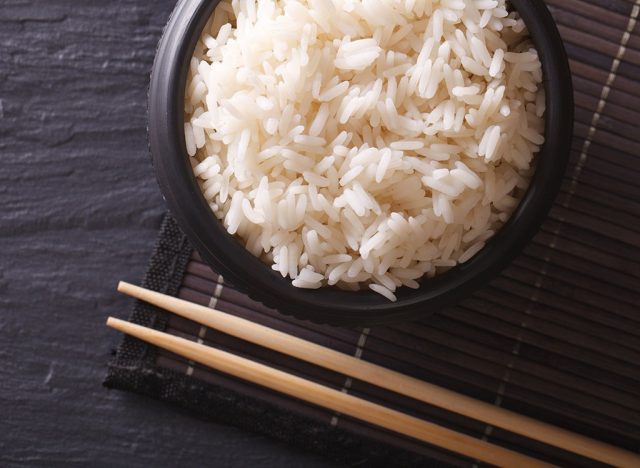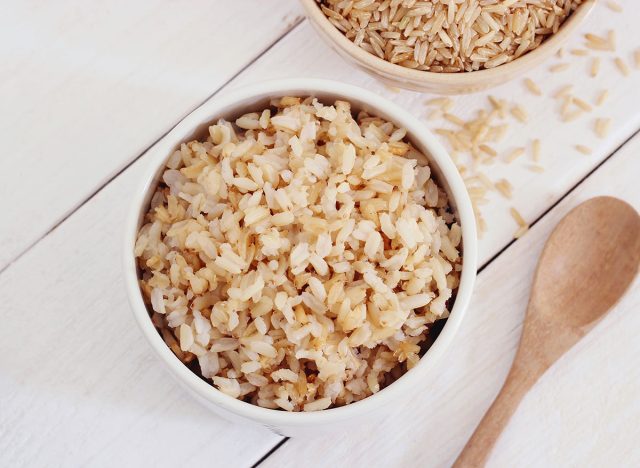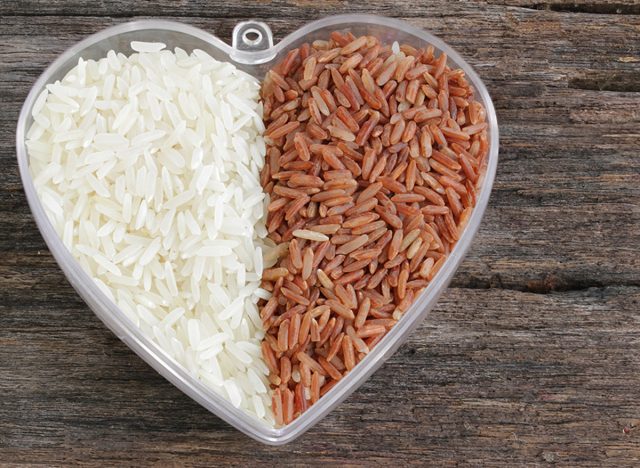Brown Rice versus White Rice: Which is the Healthier Choice?
All over the world, rice is a staple grain used for centuries in cooking. Rice is one of the most versatile grains on the market thanks to its mild flavor and fluffy texture, making it the perfect base for an abundance of proteins, legumes and other toppings.
But in recent years, due to the rise of certain fad diets that deny the nutritional benefits of carbohydrates, rice has gotten a bad rap in some circles in the United States (although it is still a staple food for more than half of the world’s population). Despite what some “influencers” claim on social media, rice can be part of a healthy lifestyle, and this timeless grain can provide plenty of nutrients that are often overlooked.
When it comes to types of rice, which one stands out as the winner in the nutrition department? There are a variety of rice varieties to analyze, but since white and brown rice are the two that are relatively available and familiar to many, let’s determine which of the two is a “better” choice. It’s white rice vs. brown rice for this ultimate rice nutrition showdown. Which one will be crowned the winner? Read on to find out, and for more, don’t miss 13 Healthy Rice Recipes for Weight Loss.
Nutritional comparison
Despite their color difference, white and brown rice come from the same plant, Oryza sativa, or the rice plant. The difference between white and brown rice lies in how the rice is processed.
Brown rice is known as a whole grain, meaning it contains not only the endosperm (aka, the part we usually think of as “rice”) but also the bran and germ. The bran and germ contain fibre, vitamins and antioxidants. One of the concerns with consuming white rice instead of brown is that you miss out on the nutrients found in the bran and sprouts.
White rice differs because the bran and germ have been removed, leaving only the endosperm. This is why white rice can feel softer when cooking and can be easier to eat. It also usually takes less time to cook.
Calories: 248
Fat: 2 g (Saturated fat: <1 g)
Sodium: 8 mg
Carbohydrates: 52 g (fibre: 3 g, sugar: <1 g)
Protein: 6 g
Calories: 169
Fat: <1 g (Saturated fat: 0 g)
Sodium: 9 mg
Carbohydrates: 37 g (fiber: 2 g, sugar: <1 g)
Protein: 4 g
Both white and brown rice have relatively comparable nutritional profiles with little fat and high carbohydrates. Brown rice, due to its inclusion of bran and germ, contains slightly more fiber per 1 cup at 3 grams, comparable to white rice, which contains 2 grams of fiber. And brown rice may contain more antioxidantsthanks to the lack of refinement. Both brown and white rice contain less than 1 gram of naturally occurring sugars. Brown rice contains 6 grams of protein per cup, while white rice contains 4 grams.
While it is true that some brown rice offerings may contain more micronutrients, this is not always the case. Many white rice choices are nutrient-fortified, meaning manufacturers have added nutrients to the grains that may have been lost during the refining process. When comparing unstarched rice choices, brown rice contains more B vitamins and other nutrients, such as zinc and magnesium, than white rice.
FAMILY: 8 Healthiest Rice Crispy Treats – And 2 To Avoid
Health benefits and potential risks
Brown rice
Benefits
In recent years, the benefits of incorporating whole grains into your diet have become well known. Eating brown rice is one of the easiest ways to include whole grains in your diet. Whole grains like brown rice have proven potentially lower blood sugar levelswhich can reduce the risk of developing type 2 diabetes.
Brown rice also contains one lower glycemic index than white rice. The glycemic index is a ranking system for carbohydrates based on their effect on blood sugar levels. Brown rice has a GI of 50, while white rice has a GI of 89. Those who currently live with metabolic disorders (or are actively trying to lower their blood sugar levels) may find that they are better able to stabilize levels when eating brown rice.
Brown rice contains marginally more fiber than unfortified white rice. Eating enough fiber daily can be challenging, so eating brown rice over white may have some benefits. One cup of cooked brown rice contains 3 grams of fiber, which is about 8% of the daily value for men, while for women it is about 12% of the daily fiber requirement.
Fiber is an important nutrient for increase saturation after a meal – that is, the feeling of being full and satisfied. Fiber is also associated with healthy weight maintenanceand a studyin particular, surveyed a wide range of adults and children and found that eating whole grains is associated with weight loss. Finally, fiber can too help cardiovascular health by lowering blood pressure and LDL cholesterol, which reduces the risk of developing type 2 diabetes. Brown rice is also packed with important vitamins and minerals, such as magnesium, phosphorus and B vitamins, which support various body functions. In addition, its antioxidant properties reduce the risk of chronic diseases and improve heart health.
Risks
But there are also potential risks associated with brown rice consumption. Some brown rice varieties can contain higher levels of inorganic arsenica toxic substance that can pose health risks if consumed in large amounts over time. This risk can be minimized by choosing rice from regions with lower arsenic levels and by varying one’s diet to include other whole grains. Individuals with sensitivities to high-fiber foods may experience digestive discomfort, as brown rice is less processed and thus more fibrous than white rice.
It should also be noted that brown rice contains phytic acid, which, although potentially healthy, can inhibit the body’s absorption of both zinc and iron. Soak brown rice in water can help avoid this.
FAMILY: 9 best whole grain breads on grocery shelves
White rice
Benefits
Contrary to popular belief, white rice is not without nutritional benefits. When fortified (or enriched), it contains certain fibers and nutrients such as B vitamins.
Fortified white rice is available nationwide on grocery store shelves, and this fortified formula can provide higher levels (higher than brown rice) of important nutrients that many people lack. For example, 1 cup cooked enriched white rice contains about 21% of your daily niacin (vitamin B3) value. Unenriched rice contains only about 3%. Of course, if you choose white rice that is not fortified, you may be missing out on important nutrients.
One reason people turn to white rice is that it is easier to digest than brown rice. The easy digestion is due to white rice’s naturally lower fiber levels. While fiber is something you want to consume, those with chronic digestive issues may turn to white rice more. Plus, white rice takes less time to cook than brown rice, making it more appealing on busy nights when you’re short on time in the kitchen.
Risks
While white rice has many feathers in its proverbial cap, the higher glycemic index can be a red flag for some. Some evidence suggests that consumption of white rice has been associated with a higher risk of elevated blood sugar and an increased risk of type 2 diabetes; However, stronger data are needed to confirm this. If you are currently living with diabetes or are at risk of developing the disease, it is a good idea to talk to your healthcare provider to discuss a diet plan that is right for you.
Finally, white rice may contain marginally lower antioxidant levels than brown rice due to the way white rice is processed. The antioxidants in brown rice can help ward off a host of chronic diseasesand you may not benefit from eating white rice. Therefore, if you eat white rice over brown, consider eating other sources of antioxidants such as berries, nuts and seeds.
FAMILY: 14 popular store-bought white breads, ranked by taste
Which is healthier: brown or white rice?
There is no definitive answer as to whether brown or white rice is healthier than the other. Both types of rice come from the same plant, and any differences arise from the production process. Although brown rice has grown in popularity across global health circles, white rice can also be part of a healthy diet.
One food will not make or break your diet. White rice is a staple food in many cultures around the world and is often included in various traditional dishes. Brown rice offers a unique texture that goes well with many foods. Both can be part of a balanced and healthy diet. The key lies in what you combine your rice with and your overall dietary choices. Enjoy what you love, and remember it’s all about balance.
FAMILY: The 10 Healthiest Whole Grains You Can Eat
The post Brown rice vs. white rice: are you healthier? appeared first on .





